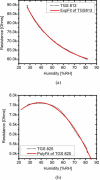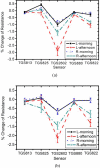Detection and classification of human body odor using an electronic nose
- PMID: 22399995
- PMCID: PMC3290469
- DOI: 10.3390/s90907234
Detection and classification of human body odor using an electronic nose
Abstract
An electronic nose (E-nose) has been designed and equipped with software that can detect and classify human armpit body odor. An array of metal oxide sensors was used for detecting volatile organic compounds. The measurement circuit employs a voltage divider resistor to measure the sensitivity of each sensor. This E-nose was controlled by in-house developed software through a portable USB data acquisition card with a principle component analysis (PCA) algorithm implemented for pattern recognition and classification. Because gas sensor sensitivity in the detection of armpit odor samples is affected by humidity, we propose a new method and algorithms combining hardware/software for the correction of the humidity noise. After the humidity correction, the E-nose showed the capability of detecting human body odor and distinguishing the body odors from two persons in a relative manner. The E-nose is still able to recognize people, even after application of deodorant. In conclusion, this is the first report of the application of an E-nose for armpit odor recognition.
Keywords: E-nose; PCA; biometrics; body odor; deodorant; humidity correction algorithm.
Figures








References
-
- Barié N., Bücking M., Rapp M. A Novel Electronic Nose Based on Miniaturized SAW Sensor Arrays Coupled with SPME Enhanced Headspace-analysis and Its Use for Rapid Determination of Volatile Organic Compounds in Food Quality Monitoring. Sens. Actuat. B. 2006;114:482–488.
-
- Vestergaard J.S., Martens M., Turkki P. Application of an Electronic Nose System for Prediction of Sensory Quality Changes of a Meat Product (Pizza Topping) During Storage. LWT. 2007;40:1095–1101.
-
- Vinaixa M., Vergara A., Duran C., Llobet E., Badia C., Brezmes J., Vilanova X., Correig X. Fast Detection of Rancidity in Potato Crisps Using E-noses Based on Mass Spectrometry or Gas Sensors. Sens. Actuat. B. 2005;106:67–75.
-
- Panigrahi S., Balasubramanian S., Gu H., Logue C.M., Marchello M. Design and Development of a Metal Oxide Based Electronic Nose for Spoilage Classification of Beef. Sens. Actuat. B. 2006;119:2–14.
LinkOut - more resources
Full Text Sources
Other Literature Sources

